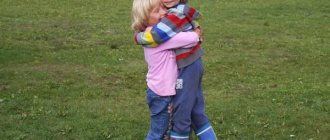The wild boar is a representative of the artiodactyl order of the pig family. Forms a separate genus. It has another name - boar or wild pig.
Outwardly very different from its domestic counterpart. Boar is denser. Compared to the domestic pig, it has longer legs. The head is elongated. They have long erect ears. Males have large lower and upper canines. The fur on the body is long and hard, thicker in winter and less frequent in summer. It can be dark grey, brown or black. There is a mane on the head and back. The muzzle, legs and tail are usually black. In some areas of Central Asia you can find light-colored individuals.
Wild pig (Sus scrofa).
Boar dimensions
The boar can have different sizes, it depends on the area where it lives. The northern inhabitants are larger than the southern ones. The smallest wild boars live in southeast Asia and southern India, weighing about 45 kg. Individuals living in the Carpathians can weigh up to 200 kg. The largest representatives of the genus live in the northeastern part of Europe, right up to the Urals. Their weight reaches 300 kg. The largest recorded weight of this animal was 320 kg. In Italy you can find a boar weighing 150 kg, and in France - 230 kg.
On average, the weight of an adult varies from 80 to 120 kg. Their body reaches 0.9-2 meters in length. At the withers they grow to 55-110 cm in height.
They have a tail, the length of which is 15-40 cm. Males have long fangs protruding outward. Females, unlike males, have small fangs that are not visible outwardly. The offspring of wild boars up to 6 months of age differ in color from adult individuals; they have light, yellow and brown stripes along their body. This color perfectly camouflages from predators.
Appearance and features
Body structure of a wild boar
A wild boar is visually similar to a pig, but due to harsher living conditions it has characteristic differences. Adults have a massive body covered with hair. Beneath it are hidden strong and durable muscles that can withstand high loads.
The body is round in shape, supported on short legs. At the back there is a small tail covered with sparse hair. Due to the narrow pelvis and wide sternum, the boar looks like a barrel.
The head is connected to the body by a wide neck. The muzzle is elongated, with high-set eyes. The nose is located above the mouth in the form of a dark spot. At the level of the forehead, at the edges, there are ears sticking up. Long fangs grow at the edges of the mouth, which are the main distinguishing feature of wild boars from other pigs. They help tear up soil and foliage to search for food, and are also used for defense and attack.
Interesting fact : adult boars' tusks can grow up to 25 cm in length. Their average length is 15-17 cm.
The hair of wild boars is hard and unpleasant to the touch. The color depends on the place of residence of the individual. Color varies from gray to dark brown. Those species that live in cool areas acquire thicker fur with the onset of winter, which allows them to survive in the snow.
Interesting: Unexpectedly dangerous animals - list, names, why they are dangerous, photos and videos
The animal grows up to a meter in height and up to two meters in length. Due to their massive body, wild boars have a large mass, which in adult individuals averages 150-200 kg, but especially developed ones can weigh up to 300 kg. Males grow much larger than females.
For Russia, wild boars are not uncommon. The country is home to five subspecies with unique appearance features:
- Central European wild boars are small in size and have dark skin;
- The Ussuri has large dimensions, but the main distinguishing features are small ears and white fluff under the nose, reminiscent of a mustache;
- the Caucasian has light fur and a large muzzle;
- Transbaikal - a small animal with a brown color;
- The Central Asian has light hair on the body and dark hair on the legs.
Despite the visual differences between the species, it is always easy to see that they belong to the wild boar family.
Wild boar habitat
Wild boars are common inhabitants of Russian forests.
Preferred habitat is wooded areas and marshy areas. The boar loves to lie in the swamp mud. Representatives of this genus live in Europe, central, southeastern and eastern Asia, the Middle East, India and northern Africa. This animal is not found in steppe areas, mountains and arid areas.
The wild boar lives in some areas of Siberia; it can be found in the Krasnoyarsk Territory and in the southern part of the Irkutsk region. Today it lives in the forests of the Moscow region and in territories located to the north. In search of food, it can climb into high mountain meadows, but the altitude should not exceed 3300 meters. In Kazakhstan and Central Asia, he chose coniferous and deciduous forests for living, and fruit forests in the Caucasus.
In the 13th century, these animals disappeared from Great Britain, in the 19th century from Denmark, and at the beginning of the 20th century, wild boars disappeared from Austria, Germany, Italy and northern Africa. In 1930, the wild pig was almost completely exterminated in Russia. However, since 1950 the population began to revive. Today, the wild boar lives even in Foggy Albion.
They also live in wildlife parks in England. The largest population lives in Sweden. Its population is more than 100 thousand individuals. Representatives of the genus are also found in North America, more precisely, in the eastern part of the USA, where they were brought specifically for hunting. There is a population in Australia, but it is not wild boars that live there, but domestic ones that escaped from farms, went wild and have now adapted to life in the wild and continue to reproduce. In behavior and lifestyle, representatives of this population do not differ from wild boars, but still are not them.
Wild pigs can sometimes be dangerous even to humans.
Boar behavior and nutrition
Females live in groups, the number of which can reach up to 50 individuals. The mature female dominates there. Males prefer a solitary lifestyle and come into groups only during the mating season. They hunt and search for food in the morning and evening twilight. During the day and night hours, wild boars prefer to rest. These animals have excellent hearing and an excellent sense of smell, but their vision is weak.
Thanks to their tusks, wild boars can dig the ground and get out rhizomes, tubers, and plant bulbs. This is their main food. They also feed on berries, fruits, and nuts. In spring and summer, they eat young grass, leaves of trees and shrubs, and shoots. From animal food they eat bird eggs, worms, insects, fish, they love frogs and snakes. They also eat carrion, as well as young lambs and deer. Boars are excellent swimmers and can easily cross a lake or river. They run well, can reach fairly high speeds, and given their size and weight, they are very dangerous for enemies.
A female wild boar with offspring.
Features of character and lifestyle
Wild boars try to settle in places where there are swampy and watery areas nearby. Animals have weak vision, but their sense of smell is highly developed. They can smell the source of the smell from half a kilometer away. This protects them from human attacks, and the latter has to use various deceptive means in the form of hunting sprays to get close to him. If a wild boar smells a dubious odor, it can quickly flee to other territories. The beast's hearing is also highly developed.
Interesting: Interesting facts about lions, photos and videos
Wild boars live together, forming herds of up to 50 individuals. Among them are young males and several experienced females who lead the herd. Adult male boars prefer to lead a solitary lifestyle, coming to the others only for the period of creating offspring.
Animals prefer a nocturnal lifestyle. During the day they hole up in swamps and reedy areas, and at nightfall they go in search of food and water.
Interesting fact : wild boars love to take mud baths and wash themselves in swamps. However, they do this at night.
Animals have sensitive skin, so they try to roll in the dust as much as possible. This protects it from sunlight and insect bites. To have a stable source of water and dirt, wild boars like to settle in places with high humidity. But these animals do not like to live next to humans, because they see him as a threat.
Boar's mouth
The wild boar prefers to leave its secluded place only to search for food. If he is full, he practically does not move, resting in a rookery between the bushes. But despite their sedentary lifestyle, these animals can travel long distances if necessary and reach speeds of up to 45 km/h. The wild boar swims well and can cross the river from one bank to the other.
The animal is very cautious and prefers to avoid conflicts. It is easier for him to quietly escape from the territory than to fight for it. But at the same time, the boar is not a coward. If necessary, he will fight to the last to protect his offspring and himself.
For greater comfort, when the individual is not in danger, it can dig a hole with its fangs and make it its home until the time comes to leave these lands.
Reproduction and lifespan
In the wild, wild boars live 10-12 years; in captivity, animals live up to 20 years. Between November and December, wild boars go into rut. In males, a subcutaneous protective “shell” grows - muscles 2-3 cm thick. It is located on the sides and serves as protection from the fangs of an opponent, which he can injure in the fight for the female. Also during this period, animals accumulate fat.
During the mating season, males constantly participate in battles for females, and therefore they lose weight and become weaker. They have many wounds on their bodies. The winner can receive up to 8 females. The duration of pregnancy is approximately 115 days. Childbirth takes place in April. The first time a female usually gives birth to 2-3 piglets. Subsequently, she gives birth to 4-6 cubs. There are times when there may be 10-12 piglets in a litter. When there are 3 days left before giving birth, the female leaves the herd. She looks for a place for herself, digs a hole there, covers it with branches and gives birth there.
At birth, a piglet weighs from 750 grams to 1 kg. For the first 4-6 days they sit in the nest, and then the female and her offspring return to the herd. The offspring goes everywhere with their mother. The female feeds the cubs with milk for 3.5 months. Growth in these animals continues up to 5-6 years. Females become sexually mature at 1.5 years, and males at 5-6 years.
Social structure
A herd of wild boars
. Adult males live separately. Each of them has its own territory, where they feed and lead a measured lifestyle. Females prefer to unite in flocks consisting of several individuals. When the rutting season begins, males join them. After the birth of the offspring, the small boars remain with their mothers and form a large herd.
Individuals care about each other and are ready to defend themselves, entering into battle with any offenders. At the same time, young boars learn survival from more experienced ones and quickly get used to it.
Interesting: What animals live in Antarctica - species, names, descriptions, photos and videos
Boar's enemies
All predators are enemies of wild boars. But they usually attack young individuals, since adult boars are strong, large, have strong legs, and males also have sharp fangs. Therefore, the wild boar is able to repel a leopard, tiger, wolf and even a bear; in some cases the attacker dies, but more often receives serious injuries.
The main enemy of the wild pig is man.
The main enemy remains man. People hunted and continue to hunt wild boar. In most cases, the animal is killed in order to make a stuffed animal out of its head and thus demonstrate their skill as a hunter. People eat the meat of these animals; it is very tasty and nutritious. Boar bristles were used to make massage hair brushes, toothbrushes and brushes for applying shaving foam.
Nowadays, bristles are not used to make toothbrushes - it is unhygienic, but shaving brushes and hair brushes are still sometimes made from it. Painting brushes are also made from bristles. Boar skin can be eaten. Today, hunting this animal has acquired a sporting character; it is done for fun, not for food. They often hunt with dogs or hunt down prey on horseback.
If a hunter encounters a boar, especially a wounded one, then the person is in mortal danger. The animal rushes at the enemy with lightning speed, and if you do not run to the side in time, you can die. The boar does not attack again. Under normal conditions, the wild boar is not aggressive. The exception is females with offspring; if the mother decides that the children are in danger, then she will protect them to the last.
If you find an error, please select a piece of text and press Ctrl+Enter.








